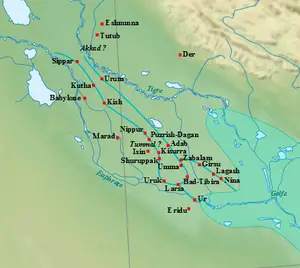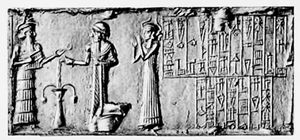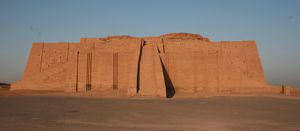How Did the Ur III Dynasty Impact Ancient Mesopotamian History
The Ur III Dynasty or the Third Dynasty of Ur (c. 2112-2004 BC) was an ancient Mesopotamian political dynasty that formed in the aftermath of the collapse of the Akkadian Dynasty. The kings of the Ur III Dynasty were able to unify southern Mesopotamia under one government, which is often viewed as a renaissance of Sumerian culture that had vanished centuries earlier. Besides briefly bringing back the Sumerian language, the Ur III Dynasty influenced later Mesopotamian dynasties in a number of different ways.
The Ur III kings not only unified much of Mesopotamia under one rule, they instituted a well-organized state and bureaucracy that was emulated by later dynasties. The Ur III kings also introduced trade and diplomatic policies that were influential, utilized agricultural practices that were used for centuries, and provided many of the basic ideas of Mesopotamian religion that were followed until the Hellenistic Period.
The Sumerians and Ur
More than a millennia before the Ur III Dynasty was born, the Sumerians began building cities in the region of southern Mesopotamia that would later become known as Sumer. The Sumerians are one of the most enigmatic ethnic groups from the ancient Near East because although their language has been deciphered, it is not a member of any known language family. The Sumerians are not believed to have been Semitic, unlike their many neighbors in Mesopotamia, nor were they believed to be Indo-European, such as the Hittites or later Persians.
The enigma of the Sumerians’ origins has led some scholars to believe they migrated to the region, possibly from India or somewhere else to the east. [1] Although this opinion was once very popular among scholars and still is in some circles, many historians and archaeologists point out that there is no evidence that suggests they migrated to the region and that if they were not truly “indigenous” to Mesopotamia they were at least very ancient. [2]
Although Ur was the capital of the Ur III Dynasty, it was a secondary city in the late fourth and early third millenniums BC. Uruk was the first and major Sumerian city, but over time as the various Mesopotamian cities battled for supremacy, Ur would emerge as the strongest. Today, the ruins of Ur are located about halfway between the modern city of Baghdad and the head of the Persian Gulf, but its location belies major differences in the ancient topography. Ur was actually located much nearer to the coast of the Persian Gulf and a few miles south of the Euphrates River. Its location near the coast along with a network of canals connected Ur to the rest of Mesopotamia and beyond as early as 6,000 BC. [3]
The Sumerians were the first people in the region to develop writing, which quickly spread from Uruk to Ur after 3,100 BC. Although much of what is known today about Ur’s early history is the result of modern archaeology, the “Sumerian King List” lists a semi-mythical First Dynasty of Ur. According to the list, the Ur kings defeated Uruk for dominance of the region.
“Uruk was defeated in battle, its kingship was removed to Ur. In Ur, Mes-Anne-pada became king, ruled 80 years; MEs-kiag-Nanna became king, ruled 36 years; [Elulu ruled 25 years; Balulu ruled 36 years. Four kings (thus) ruled it for 177 years. Ur was defeated in battle].” [4]
The Establishment of the Ur III Dynasty
The Ur III Dynasty came to power after the Akkadian Dynasty grew weak and eventually collapsed. Akkad’s collapse ushered in an era of political and social instability in Mesopotamia, but also created opportunities for ambitious dynasts in other cities. Ur-Nammu (reigned c. 2112-2095 BC) was one such ambitious ruler. After consolidating his power base within the city of Ur, Ur-Nammu used his army to bring most of Mesopotamia under the rule of Ur. A cuneiform inscription in the Sumerian language, known as the “Laws of Ur-Nammu,” documents this process, along with a number of laws the king enacted in the conquered territories. The text provides insight not only into how Ur-Nammu conquered Mesopotamia, but more importantly how he and the other Ur III kings viewed their action.
“Then did Ur-Nammu, the mighty warrior, king of Ur, king of Sumer and Akkad, by the might of Nanna, lord of the city (of Ur), and in accordance with the true word of Utu, establish equity in the land (and) he banished malediction, violence, and strife. By granting immunity in Akkad to the maritime trade from the seafarers’ overseer, to the heardsman from the ‘oxen-taker,’ the ‘sheeptaker,’ and the ‘donkey-taker,’ he set Sumer and Akkad free.” [5]
The creation and expansion of the Ur III Empire that was begun by Ur-Nammu was completed by his son and successor, Shulgi. [6] The first millennium BC Akkadian cuneiform text, the “Babylonian Chronicle,” mentions Shulgi as a conqueror, but also as a bit of a brigand.
“Shulgi, son of Ur-Namu, provided abundant food for Eridu, which is on the seashore. But he had criminal tendencies and took away the property of Esagil and Babylon as booty.” [7]
The empire that Ur-Nammu and Shulgi created was quite sophisticated in terms of its bureaucracy and state apparatus. The empire was divided into provinces that were each overseen by a governor known as an ensi. In addition to an ensi, each province also had at least one general, and several, such as the province of Umma, had several generals, which effectively prevented ensis from rebelling. Another important Ur III administrative office was the sukkalmah, whose task it was to represent the interests of the Ur III state away from Ur and who therefore acted as another check on possibly ambitious ensis. [8]
Trade and Diplomacy in the Ur III State
Related Articles
- How historically accurate is the Gladiator
- What Role Did the Canaanites Play in the Bronze Age Near East
- What Are the Origins of the Germanic Tribes
- How Did the God Baal Become Popular
- Who was Theseus the great Athenian king and hero
- How Did the Ancient Egyptian City of Thebes Become Prominent
- What Were the Origins of Ancient Macedon (aka Macedonia)
- When Did the Nubian Kingdom of Meroe Rise to Prominence
Although the first two Ur III kings established their empire through force, they were not as bellicose as many of the Mesopotamian dynasties that preceded and followed them. The Ur III kings relied on their well-oiled bureaucracy along with considerable long-distance trade and an innovative diplomatic policy to hold power. By the late third millennium BC, Ur came to dominate the textiles and metals trade in Mesopotamia, which the Ur III kings took advantage of through centralization. The Ur III kings would direct trade through policies, but trade itself was carried out by independent caravans and contractors who profited nicely. Ur III trade worked so well that some modern scholars believed that a proto-currency was even developed in Ur at the time. Gold, silver, copper, and bronze coils have been discovered in excavations at Ur in a trade context, which has suggested to some archaeologists that the metals were used as a type of early currency. [9]
Trade may have made the Ur III kings rich, but agriculture was the backbone of the Mesopotamian economy. The Ur III kings helped advance the state of Mesopotamian agriculture by further developing the already extensive irrigation networks and by introducing a three-field crop rotation. [10] The Ur III Dynasty’s trade and economic policies helped keep the empire strong internally and allowed it the luxury of conducting diplomacy in a way that expanded its interests.
Among the sukkalmah’s many duties, the most important was to act as the Ur III Dynasty’s secretary of state. The sukkalmah would take care of foreign emissaries in Ur and would arrange diplomatic events to coincide with state religious festivals. [11] As with nearly all ancient societies, the Ur III state was a theocracy in many ways and the theological ideas it established would play an important role throughout Mesopotamian history.
The Ur III Dynasty and Religion
When one thinks of ancient Mesopotamian religion, the region’s massive temple complexes are often what first comes to mind. Ziggurats were large, triangular complexes that evolved from small structures to the three story temples that came be built across Mesopotamia, Assyria, and Elam. The Ziggurat of Ur, which was dedicated to the moon god Nanna/Sin, measures 190 by 130 feet and is made of mudbrick. [12] The now two level ziggurat was once three levels and provided the inspiration for all later ziggurats.
The Ur III Dynasty also influenced later Mesopotamian dynasties in terms of religious texts. Many of the more influential Mesopotamian texts, such as the Epic of Gilgamesh were originally written in Sumerian, probably during the Ur III Dynasty, and then later copied into Akkadian in later dynasties. [13] In fact, most of the gods and goddesses of Mesopotamia were based on Sumerian and/or Ur III deities; the later dynasties would often just change their names but the important details remained constant.
Conclusion
Although it is sometimes overlooked, the Ur III Dynasty was one of the most important dynasties to have ruled ancient Mesopotamia. The Ur III kings quickly built an empire on the ruins of the Akkadian Dynasty and in the process built a sophisticated bureaucracy, developed advanced trade and diplomacy, and influenced the religion of later Mesopotamian dynasties. After the Ur III Dynasty collapsed at the hands of the Elamites, the focus of Mesopotamian Civilization moved north to Babylon, but the ideas that were developed in Ur were not forgotten.
References
- ↑ Ziskind, Jonathan R. “The Sumerian Problem.” History Teacher 5 (1972) p. 41
- ↑ Kuhrt, Amélie. The Ancient Near East: c. 3000-330 BC. (London: Routledge, 2010), p. 23
- ↑ Mieroop, Marc van de. A History of the Ancient Near East: ca. 3000-323 BC. Second Edition. (London: Blackwell, 2007), p. 142
- ↑ Pritchard, James B, ed. Ancient Near Eastern Texts Relating to the Old Testament. Third Edition. (Princeton, New Jersey: Princeton University Press, 1992), p. 266
- ↑ Pritchard, p. 523
- ↑ Kuhrt, p. 63
- ↑ Grayson, A. Kirk, ed. Assyrian and Babylonian Chronicles. (Winona Lake, Indiana: Eisenbrauns, 2000), p. 154
- ↑ Mieroop, pgs. 77-79
- ↑ Kuhrt, p. 61
- ↑ Kuhrt, p. 60
- ↑ Sharlach, Tonia. “Diplomacy and the Rituals of Politics at the Ur III Court.” Journal of Cuneiform Studies. 57 (2005) pgs. 17-22
- ↑ Frankfort, Henri. The Art and Architecture of the Ancient Orient. Fourth Edition. (New Haven, Connecticut: Yale University Press), p. 104
- ↑ Sandars, Nancy The Epic of Gilgamesh. Revised Edition. (London: Penguin, 1972), p. 8


